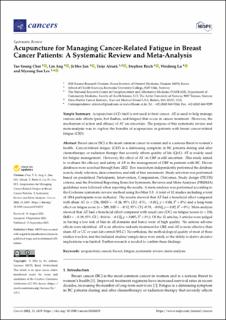| dc.description.abstract | Breast cancer (BC) is the most common cancer in women and is a serious threat to women’s
health. Cancer-related fatigue (CRF) is a distressing symptom in BC patients during and after
chemotherapy or radiation therapy that severely affects quality of life (QoL). AT is widely used
for fatigue management. However, the effect of AT on CRF is still uncertain. This study aimed
to evaluate the efficacy and safety of AT in the management of CRF in patients with BC. Eleven
databases were searched through June 2022. Two researchers independently performed the database
search, study selection, data extraction, and risk of bias assessment. Study selection was performed
based on predefined Participants, Intervention, Comparators, Outcomes, Study design (PICOS)
criteria, and the Preferred Reporting Items for Systematic Reviews and Meta-Analyses (PRISMA)
guidelines were followed when reporting the results. A meta-analysis was performed according to
the Cochrane systematic review method using RevMan 5.3. A total of 12 studies including a total
of 1084 participants were included. The results showed that AT had a beneficial effect compared
with sham AT (n = 256, SMD = −0.26, 95% CI [−0.51, −0.01], p = 0.04, I2 = 0%) and a long-term
effect on fatigue score (n = 209, MD = −0.32, 95% CI [–0.59, −0.04], p = 0.02, I2 = 0%). Meta-analysis
showed that AT had a beneficial effect compared with usual care (UC) on fatigue scores (n = 238,
SMD = −0.39, 95% CI [−0.66 to −0.12], p = 0.005, I2 = 0%). Of the 12 articles, 3 articles were judged
as having a low risk of bias in all domains and hence were of high quality. No serious adverse
effects were identified. AT is an effective and safe treatment for CRF, and AT is more effective than
sham AT or UC or wait-list control (WLC). Nevertheless, the methodological quality of most of these
studies was low, and the included studies/sample sizes were small, so the ability to derive decisive
implications was limited. Further research is needed to confirm these findings. | en_US |

